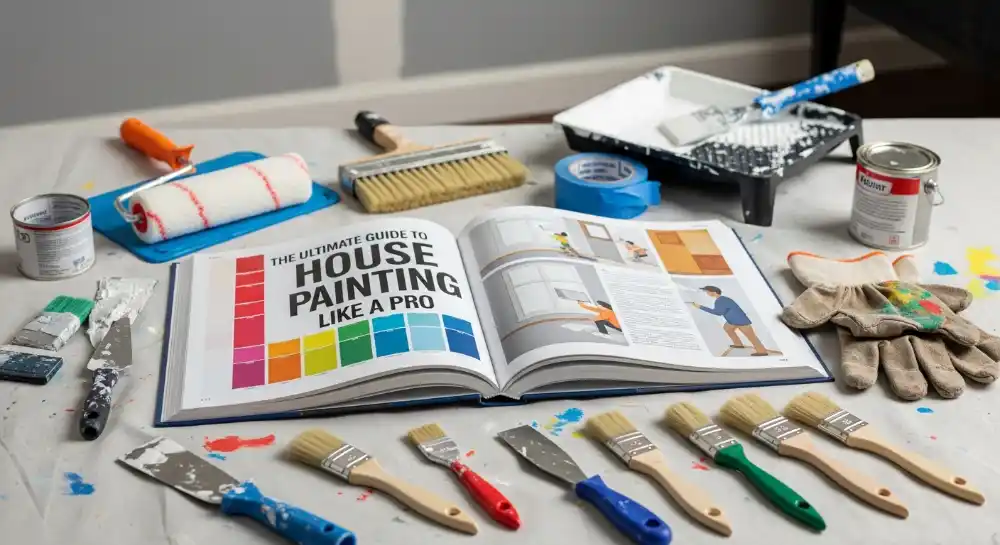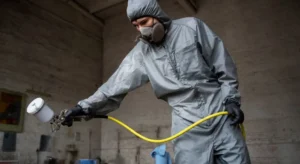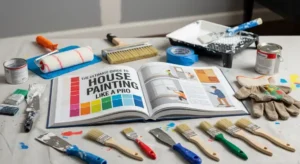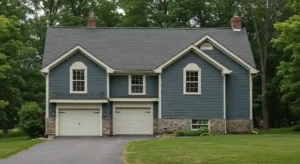Have you ever walked into a freshly painted room and felt an instant lift in mood? Or driven past a home with a crisp, new exterior color and thought, “Wow, that looks amazing!” A fresh coat of paint is one of the most transformative, yet cost-effective, ways to refresh your living space. It’s not just a color change; it’s a chance to rework your home’s appearance and character.
If you’re finally ready to get around to getting that paint job done, you’re in the right spot. This ultimate guide breaks down everything from choosing the perfect shade to mastering professional techniques, providing you with all the essential house painting tips you need. Whatever you want in fresh house painting styles for a cozy in-house revamp or creating a complete outside house painting overhaul, you’ve come to the correct place.
For this article, we’ll guide you through it. Let us discover the fantastic difference a fresh coat of paint can create and why it is a wise investment. Get your home ready to shine. Ready to give your home a fresh new look? Explore our Professional Painting Services to see how our expert painters can bring color, quality, and style to every room.
Why House Painting Matters
Paint is the first line of defense for your home, whether on the inside or the outside. It is a weather barrier, a wear barrier, and an aging barrier. Apart from why it is there, it works well for how good your property looks. A fresh coat of paint instantly adds exterior attractiveness to your house and makes it appear tidy and well-maintained.
Paint the house as an investment in your home’s long-term health and value. It’s one of the components of any good redesign plan for your home. New paint covers surfaces, seals drying wood, and inhibits moisture-carrying mold and mildew growth. This protection is essential to avoid more expensive repairs down the line.
A new, professional coat of paint is an excellent way to improve the apparent and real value of property. To hear more about this benefit, read more about Why Repainting Your Home Increases Property Value. Choosing whether to do this project yourself or hire someone else can also affect your wallet and the result. Be sure to take a look at DIY vs Professional Painting: Which Saves More? to make the optimal choice for your situation.
Choosing the Right Paint Type for Your Walls
The selection of paint is as important as the painting itself. There are a vast number of choices in the market, designed for different surfaces, situations, and results.
For your interior, think about what will be happening in the room. Bathrooms and kitchens are wet areas that must be painted with mold-fighting paint, and busy rooms are best painted with hard, easy-to-clean surfaces. Semi-gloss paint finishes are ideal for trim work, and eggshell or matte finishes are suitable for walls when painting the interior of a house.
For your house’s exterior, the secret is choosing the right paint. You will need a formula that can withstand intense sun, heavy rain, and temperature changes. Elastomeric and acrylic latex are excellent choices due to their elasticity and durability. Quality is not only accessible in high-end, but you can also use many colors from Home Depot’s comprehensive color collection.
If you are a citizen of a green problem, keep in mind the effect this decision will have. Many things today come with low- or zero-VOC (volatile organic compound) paint, making them a better choice for the planet in your home and the world. Learn more about greener options by finding out more about Eco-Friendly Painting: What Are Low-VOC Paints?
The finish type you choose also has a significant impact on the result. You can discover the different options in our Matte vs Gloss Paint: What’s the Difference? Guide and the best application for each in our Different Types of Paints and Their Uses guide.
Interior vs Exterior Painting Tips
Exterior and interior painting of a house are two distinct tasks, both with their own unique problems, materials, and techniques.
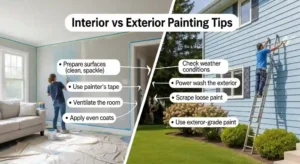
Exterior house painting requires more planning due to the weather. The temperature and humidity will play a significant role in paint adhesion and drying. Wood, stucco, or siding surfaces all offer different exterior house paint application and preparation methods to ensure the paint withstands.
Interior painting is all about thoroughly masking, covering furniture, and ensuring even coverage in poorly ventilated areas. Prep is the key to a perfect finish, i.e., patching the holes and sanding to smooth. Indoor climate is more controlled, but neat work under trim and ceiling areas is the difference between an acceptable and a professional job.
Before any project, particularly outdoor work, it is always best to consider the weather. Discover the ideal weather for a flawless paint job in our Best Season to Paint Your Home—Weather & Humidity Tips. You will also be amazed at the diversity of paint types; discover the inside scoop on exterior vs interior paint differences.
Step-by-Step House Painting Process
A professional house painting task involves 80% preparation and 20% work. Leaving out the preparation ensures a disappointing outcome. In an orderly sequence, efficiency and an excellent result are assured.
- Surface Preparation: The key step. Interior walls, i.e., cleaning, spackling and sanding holes, and sanding ridges. Exterior power washing, scrubbing, peeling old paint, and priming the areas of exposed wood.
- Masking and Taping: Taping with high-quality painter’s tape over hardware, windows, and trim keeps them from being painted. Drop cloths should be used to cover furniture and floors. This isn’t to get a sharp, clean edge.
- Primer: Primer excludes porous surfaces, halts stains, and offers a color base for the topcoat. Never omit primer, particularly when changing colors drastically or painting new bare wood or drywall.
- Painting: Begin with the ceilings, then the trim, and finally the walls when painting a room. Use the ‘cut in’ method with a brush along the edges, then use a roller for most of the wall area. Working with a wet edge to prevent lap marks. For more in-depth house painting advice, refer to our beginner’s guide.
- Clean Up: Allow the tape to come off when the paint is wet for the best lines. Please dispose of your equipment immediately so it’s ready for the next project. Even experts do things wrong, so learn how not to do them yourself with our guide to Common Painting Blunders to Avoid. For information on interior work, see the How to Paint a Room: Beginner’s Guide.
Essential Painting Tools You’ll Need
With the tools required, the job is easy, quick, and convenient. You do not need to have the entire set at your disposal at all times, but there are a few painting tools you can never live without.
Brushes: You’ll need some high-quality brushes of different sizes (1.5 to 3 inches). Angled brushes are best for ‘cutting in’ edges and trim.
Rollers: Use the proper nap (roll cover thickness) on your surface. A thick nap will work best for textured ceilings or heavy exterior house paint, while a light nap is best for smooth interiors.
Paint Trays and Liners: Liners are more sanitary and spare you the hassle of cleaning a sticky tray after each break.
Drop Cloths and Tape: Use canvas drop cloths instead of plastic, as canvas is less slippery and more resistant. High-quality painter’s tape has less bleed-through.
Ladders and Extension Poles: A heavy-duty step ladder is a must. An extension pole for your roller keeps your back happy and lets you work faster on exterior walls and high paintwork.
Double-check that you’re prepared before beginning with the entire Essential Painting Tools Checklist for Homeowners. And for guidance on how to pick the right equipment for various materials, click How to Choose the Right Painting Equipment for Your Home.
Home Painting Ideas & Inspiration
Color is subjective, but it can’t hurt to know about home color schemes and concepts to help you make your decision. The right tone can totally change the mood of a room and its lighting.
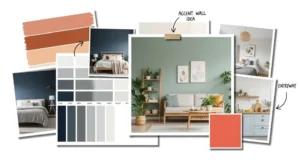
Interior Trends: Home paint colors are trending towards warm neutrals, deep jewel tones as accent walls, and older, soothing blues and greens. Think about how the room will be used. A soothing color palette is excellent for bedrooms, but dark-colored shades will get a home office or kitchen started.
Outdoor Trends: Home Depot color paint knows no bounds when it comes to your exterior. Classic white and soft greys are ageless, but bolder earth tones or navies are in the most significant demand.
Strategic color sets the tone in a space. Learn how to revitalize your rooms with bold color pairings in our guide, Accent Walls: How to Use Paint for Modern Interiors. How natural and artificial light can be seen in a room greatly influences what a color appears to be; locate this influence in How Lighting Affects Paint Color and Wall Mood. For current trends, see the Trending Wall Colors for 2025, Home Paint Ideas.
Common Painting Mistakes to Avoid
Even with the best of intentions, a series of simple errors can ruin your finish and reduce the life of your paint job. Understanding these common painting errors will save time and frustration.
- Failure to prepare: As mentioned earlier, this is the most common and expensive mistake. Applying a coat over grime, grease, or blistered paint will result in early peeling.
- Low-Cost Brushes: Low-cost brushes imprint, and low-cost rollers cause bubbles and fuzz on the wall. Pay a little extra and enjoy much better finishing.
- No Primer: From dark to light or spot areas, primer is necessary for proper color saturation and even absorption.
- Too Heavy a Coat: It creates drips, sags, and unevenness. Two thin coats always yield better results than one heavy coat.
- Painting Under Substandard Conditions: High heat or dampness impacts drying and adhesion, typically leading to disappointing outcomes. It plays a significant role in successful house interior design, painting ideas, and exterior use as well.
To remain on course, remaining on the right path from beginning to end, walk through our step-by-step house painting process. Just reading about paint can even avoid errors; read the facts in our article on How Paint Chemistry Works: Finishes and Textures.
DIY vs. Professional Painters: What Is Best?
If you also include the extent of the entire project—prep to cleanup, you must consider the DIY effort and time versus professionals’ experience and the average cost of exterior house paint.
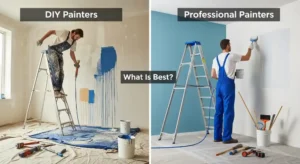
DIY (Do-It-Yourself): It is cost-saving on labor and offers total control over timing. It takes an unimaginable amount of time and tool buying, and overall produces an imperfect finish for non-professional homeowners.
House Painter Experts: Expert house painters ensure a durable, professional-quality finish is applied accurately. They have the appropriate gear, equipment, and house painting expertise to deliver the optimal finish, typically saving you from wasted materials and errors.
You would want to choose a solution that balances your free time, skill level, and budget equally. DIY vs Professional Painting: Which Saves More? To observe the cost and time compared from a bird’s eye view, see How Much Does House Painting Cost? Professional house painters bring peace of mind and an improved quality finish, as explored in more detail in our guide, Why Hire Professional Painters for Your Home.
How Much Does House Painting Cost?
The cost of house painting can vary significantly based on factors such as the size of the area, the quality of the paint, the amount of prep work, and whether you’re hiring pros.
Factors That Affect Cost:
- Labor: It is the most costly component of the cost. Exterior house painting is pricier than interior painting because access equipment, ladders, and scaffolds are required.
- Materials: More costly, higher-quality paint will cost more but will endure longer.
- Preparation: Heavy scraping, power washing, and repair will be included in the end cost.
- Surface: Tricky surfaces, like detailed trim or fancy gables, cost more and take longer.
To gain some idea of how much to paint a house, you’ll usually get an estimate in terms of square footage and job difficulty. To learn the full cost breakdown, check out our House Painting Cost Breakdown—Full Estimate Guide.
Maintenance & Longevity, Make Your Paint Job Last
A quality paint job is meant to last decades, yet the right amount of maintenance will do wonders to extend its lifespan and keep it looking new. That applies to both the exterior of your house and the interior walls of your residence.
Cleaning: Daily, interior walls are cleaned with a gentle cleaner, wiping away dirt and dust that dulls color. Occasionally, outside power washing (when necessary) gently removes dirt and mildew before they can cause damage. See the proper method in How to Clean and Care for Painted Walls Without Damaging.
Touch-Ups: Save some of your remaining paint in a convenient container for speedy touch-ups on scratches and scrapes. Fixing minor flaws along the way prevents them from becoming big problems. These painting shortcuts are simple but will save you a whole lot of hard work in the long run.
Retouch: Paint is not permanent. Sunlight, weather, and the usual wear and tear over time necessitate a retouch. Find out when to retouch your paint in How Often Should You Repaint Your House?
Environmental & Seasonal Painting Tips
Being respectful about when and what you choose to do with paint can make it greener and result in a cleaner finish.
Environmental Options: Using environmentally friendly painting materials, such as low-VOC paint, reduces the emission of harmful chemicals into the air. It provides a cleaner indoor setting throughout and after painting. Discover all the advantages of eco-friendly painting: What Are Low-VOC Paints?
Seasonal Timing: For outdoor work, timing is everything. Steer clear of painting during direct, bright sun because the paint would dry too fast, resulting in brush strokes or failing to stick well. Ideal conditions are moderate temperatures and low humidity. Timing is also essential for interiors, as you’ll want good ventilation. Find the perfect window for your project in Best Season to Paint Your Home—Weather & Humidity Tips. Also, review the specific seasonal problems in Exterior vs. Interior Painting: What to Consider Seasonally.
Educational Section: Paint Chemistry Education
You will be able to make more informed product decisions and know why various finishes perform differently by learning about paint ingredients.
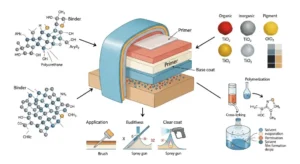
Paint is made up mainly of four ingredients:
- Pigments: They create color and opacity.
- Binders (Resins): They create the film that holds the pigment and regulates adhesion and toughness.
- Solvents (Carriers): These are liquids that render the paint (water-based or oil-based) suitable for use. It is what hardens when dry paint hardens.
- Additives: They provide special properties such as resistance to mildew, improved flow, or rapid drying.
Binder and solvent are mixed to form a paint, latex (waterborne), or oil-based (alkyd). Matte and gloss paint result from the mixture of the pigments and binders. Find out more about the chemistry in our article on How Paint Chemistry Works: Understanding Finishes and Textures, and double-check your finish choices in Matte vs Gloss Paint: What’s the Difference?
Final Thoughts
A fresh coat of paint is probably the last remodel you can do. It protects your investment, enhances exterior attractiveness, and adds a new, clean look to your interior areas. You’re thinking about speeding up; with the right house painting tips and facts, you’re ready to start.
If it’s beyond your ability to handle, know professional painters are standing by to deliver a flawless, durable finish. They prep, paint technically, and clean, and you get quality work far better than the constraints of a time-bound DIY job. If you’d love to experience the difference professionalism can make, we encourage you to contact our professional painters today to schedule a consultation. Visit our entire portfolio of services on our Painting Services page, or see our Interior and Exterior Painting Services individually. Let’s make your home the beautiful home it can be.
FAQs
Q: Do I paint most of the wall with a roller or a brush?
A: Paint the corners and edges with a brush and the significant, flat areas of the wall with a roller for a smooth, faster coverage, as outlined in our Step-by-Step Painting Process.
Q: What are the most popular house colors outdoors?
A: Neutrals in the form of warm greys, light whites, and soft beige shades remain the top favorite home colors for the outside of houses since they are so ageless.
Q: How long does exterior paint typically last?
A: High-quality, correctly applied exterior paint will last 5 to 10 years, depending on the grade of paint used, weather patterns, and original surface preparation.
Q: How much paint will I need?
A: Two coats will usually be required for optimal color saturation, particularly where the coloring is changing or concealing a repaired area.
Q: Can I repaint peeling paint?
A: No, you will need to scrape, sand, and prime the peeling surfaces beforehand; the new paint peels very easily along with the original finish.
Q: Can I paint my house in the winter?
A: Can paint interior but not exterior in winter because most paints are below some temperature at which they won’t stick and dry.
Q: How do I plan my budget?
A: Estimate your budget by calculating the area to be painted, the quality of the material price, and whether to hire professionals or not; refer to our House Painting Cost Guide.
